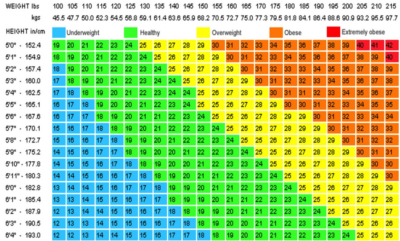 Body mass index charts (BMI for short) have been used as a tool for assessing public health and risk factors associated with obesity since the 1970’s. It is a relatively simple measurement. Using the chart above take your height and weight and see where the lines intersect. The number you land on places you in either underweight, healthy, overweight, obese, or extremely obese categories. Simple right? There are some complications.
Body mass index charts (BMI for short) have been used as a tool for assessing public health and risk factors associated with obesity since the 1970’s. It is a relatively simple measurement. Using the chart above take your height and weight and see where the lines intersect. The number you land on places you in either underweight, healthy, overweight, obese, or extremely obese categories. Simple right? There are some complications.
The best use for this chart is to determine the overall health and obesity risk of an entire population. For example, if we determined that the population of Frankfort, IL was 5’9 and 145 pounds we could say that the average Frankfort resident falls into a healthy body weight category. For individual use, the BMI is a little more controversial, as it does not take into account body composition, aerobic health, muscle mass etc.
Now that isn’t to say that there isn’t value for it as an individual diagnostic tool. If you find yourself in the overweight category near 27, 28, or 29 you may be thinking “that’s preposterous, I’m not overweight!” That was me (Dr. Matt) about 8 years ago. I was 5’10 and at the time weighed over 220 pounds. I was incredibly strong as I had been focused on weightlifting and strength sports for the previous ten years. When I would see my overweight (near obese) designation on the chart, I would scoff and say “that’s absurd, it doesn’t take strength into account!” However, when I went to join the Army I had to come to a serious self reflection point. Sure, I was strong and worked out 5-6 times per week, but I had to be very careful when getting my blood pressure tested! I was carrying around 22 percent body fat and while I was capable of running, my aerobic fitness was garbage. I had numerous signs pointing to looming health issues had I continued down that road. Fast forward to today and I’m 5’10 and about 190 pounds and all previous health concerns are out the window.
Despite my improving score on the BMI, there is another marker of overall health that I am more concerned with these days, and it is likely a much more relevant and revealing marker of overall health and weight related chronic disease risk factors, waist to height ratio. This is another simple measure. Take a tape measure (like one used for sewing) measure around your waist at the level of the belly button. Pull it tight to your skin but not so tight that skin folds over the tape measure. Take the measurement in inches or centimeters and compare it to your height in inches or centimeters (be consistent in the units you use). Divide your waist by your height. My waist across my belly button is 34.5 inches and I am 70 inches tall. 34.5/70=49.2%.
Numerous studies have been conducted looking at waist circumference compared to height and they all seem to agree that 50% or less is a good metric to aim for. A waist circumference greater than 50% of your height is associated with metabolic disorders, insulin resistance, and poor lipid profiles (among other risk factors).
Rather than relying on the BMI as a diagnostic tool consider measuring waist circumference. Reducing your waist line is a better health related goal than simply weight loss, though the two usually go hand in hand.

